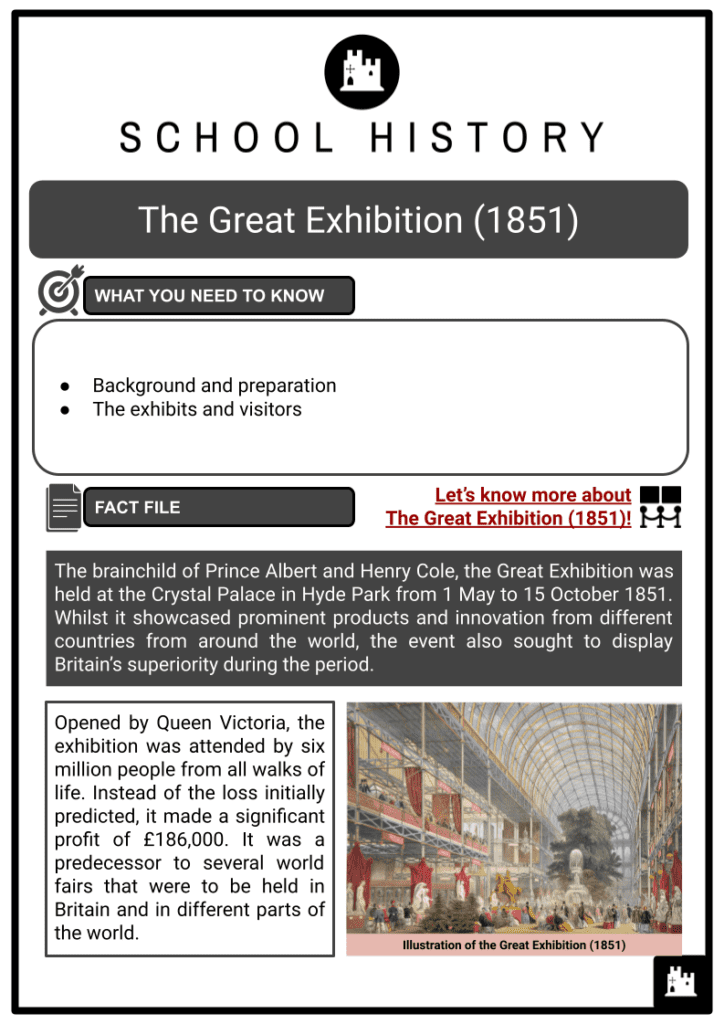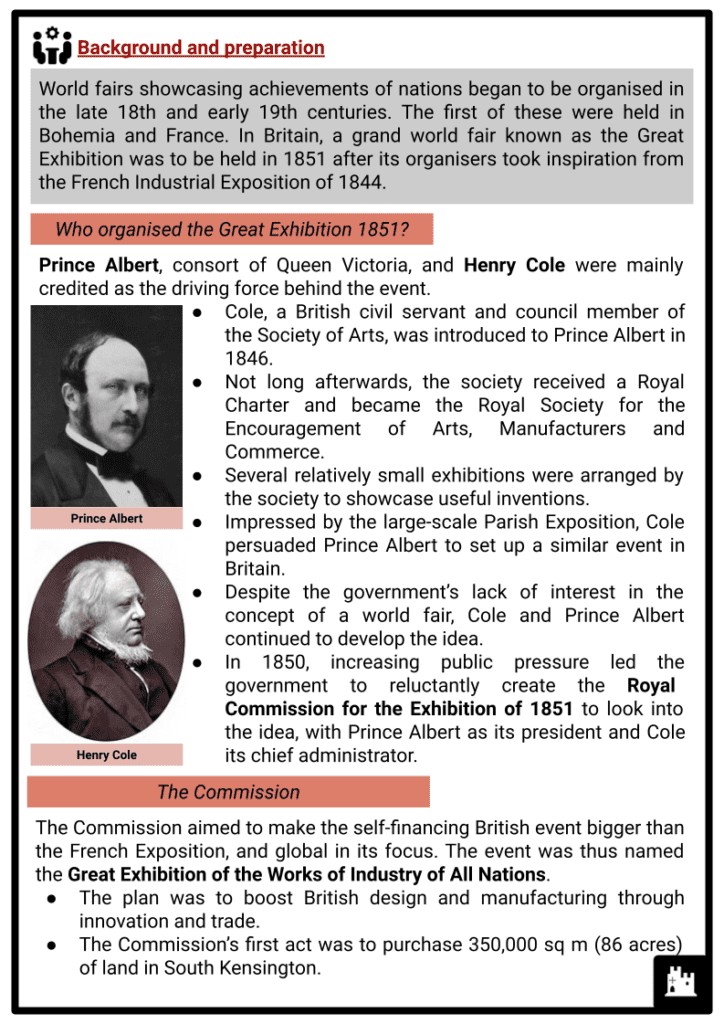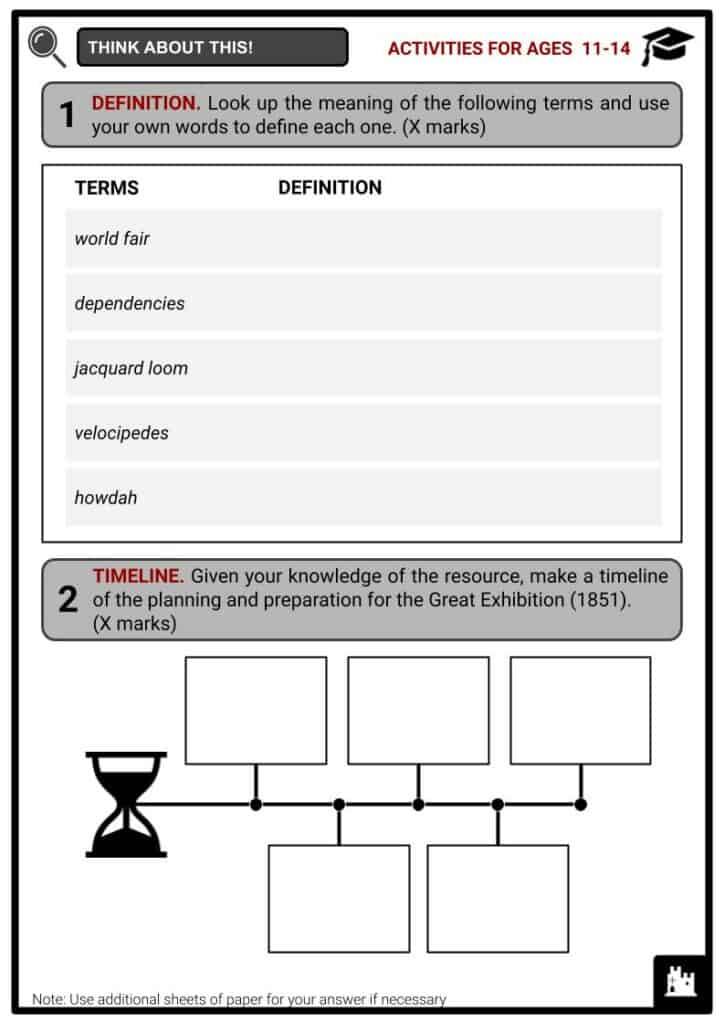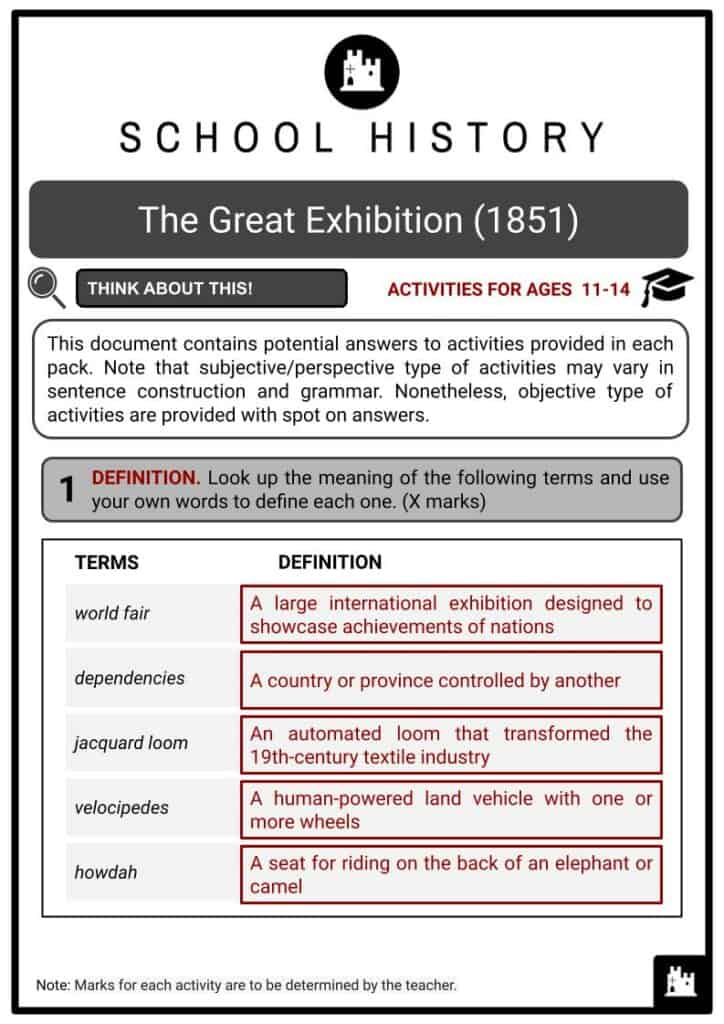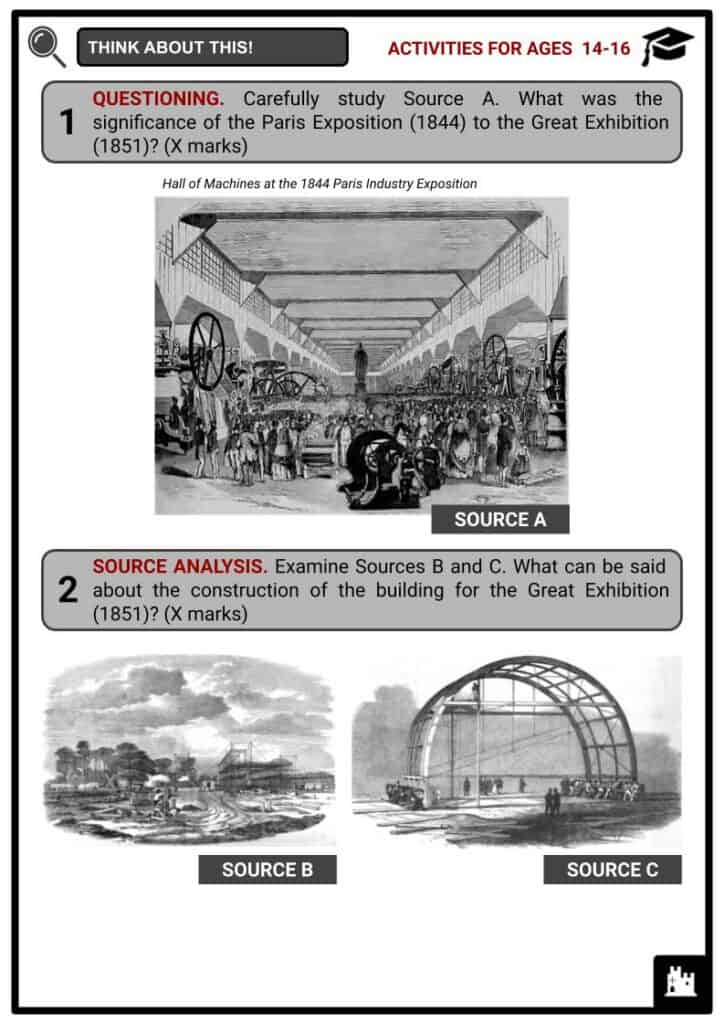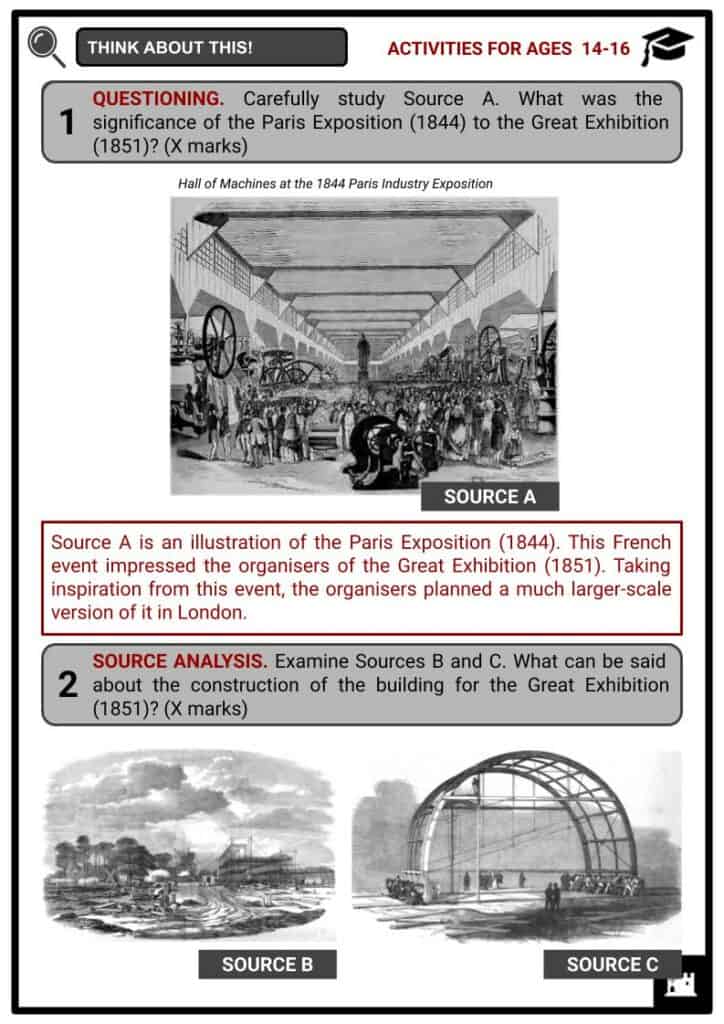Download The Great Exhibition (1851) Worksheets
Do you want to save dozens of hours in time? Get your evenings and weekends back? Be able to teach about The Great Exhibition (1851) to your students?
Our worksheet bundle includes a fact file and printable worksheets and student activities. Perfect for both the classroom and homeschooling!
Summary
- Background and preparation
- The exhibits and visitors
Key Facts And Information
Let’s know more about The Great Exhibition (1851)!
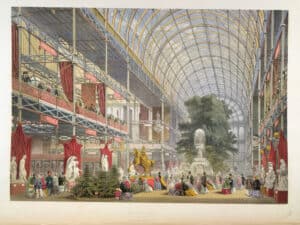
The brainchild of Prince Albert and Henry Cole, the Great Exhibition was held at the Crystal Palace in Hyde Park from 1 May to 15 October 1851. Whilst it showcased prominent products and innovations from different countries from around the world, the event also sought to display Britain’s superiority during the period.
- Opened by Queen Victoria, the exhibition was attended by six million people from all walks of life. Instead of the loss initially predicted, it made a significant profit of £186,000. It was a predecessor to several world fairs that were to be held in Britain and in different parts of the world.
Background and preparation
- World fairs showcasing achievements of nations began to be organised in the late 18th and early 19th centuries. The first of these were held in Bohemia and France. In Britain, a grand world fair known as the Great Exhibition was to be held in 1851 after its organisers took inspiration from the French Industrial Exposition of 1844.
Who organised the Great Exhibition 1851?
- Prince Albert, consort of Queen Victoria, and Henry Cole were mainly credited as the driving force behind the event.
- Cole, a British civil servant and council member of the Society of Arts, was introduced to Prince Albert in 1846.
- Not long afterwards, the society received a Royal Charter and became the Royal Society for the Encouragement of Arts, Manufacturers and Commerce.
- Several relatively small exhibitions were arranged by the society to showcase useful inventions.
- Impressed by the large-scale Parish Exposition, Cole persuaded Prince Albert to set up a similar event in Britain.
- Despite the government’s lack of interest in the concept of a world fair, Cole and Prince Albert continued to develop the idea.
- In 1850, increasing public pressure led the government to reluctantly create the Royal Commission for the Exhibition of 1851 to look into the idea, with Prince Albert as its president and Cole its chief administrator.
The Commission
- The Commission aimed to make the self-financing British event bigger than the French Exposition, and global in its focus. The event was thus named the Great Exhibition of the Works of Industry of All Nations.
- The plan was to boost British design and manufacturing through innovation and trade.
- The Commission’s first act was to purchase 350,000 sq m (86 acres) of land in South Kensington.
- The Commission set up a competition for a building design for the Great Exhibition and received 245 submissions by its deadline.
- However, two of the particularly favoured designs would take too long to build and would be too permanent.
- Hyde Park was the designated location of the structure and at the time there was a public outcry against its desecration.
- Ultimately, the Commission chose a design of a prefabricated iron-framed building with a glass exterior by Joseph Paxton, a greenhouse builder.
- When the design was published, it gained a great deal of praise and support from the people. The structure was dubbed the Crystal Palace, a name that stuck from then on.
- The Crystal Palace was 563 m (1,848 ft) long, 124 m (408 ft) wide and 33 m (108 ft) high.
- During the construction, Paxton was assisted by Charles Fox for the iron framework, and William Cubitt, Chairman of the Building Committee.
- The building used 4,500 tons of iron, 5,600 sq m (60,000 sq ft) of timber, and over 293,000 panes of glass, and cost around £80,000.
- Work started on 1 August 1850, and the construction was made possible by increasing the workforce from around 40 at the start of the build, to around 2,000 by its completion.
- When the Crystal Place was completed, it was itself a demonstration of British technology in iron and glass.
- It was, at the time, the largest glass building in the world, stretching three times the length of St Paul’s Cathedral.
- It had three entrances, seventeen exits and ten double staircases. Standing 8 m (27 ft) high in the middle of the building was the Crystal Fountain made of four tons of pink glass.
The exhibits and visitors
-
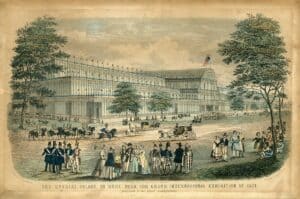
Illustration of the Crystal Palace The Great Exhibition sought to prove that technology was the key to a better future. Whilst it was a platform on which countries from around the world could unveil their prominent inventions and achievements, in practice it turned into more of a showcase of Britain’s superiority.
- On 1 May 1851, the Great Exhibition was opened by Queen Victoria, who later became a frequent visitor.
- Running until 15 October the same year, its average daily attendance was around 42,000 with a peak attendance of 109,915 on 7 October.
- Numerous famous people of the time attended the event, as well as factory workers, country villagers and strings of schoolchildren.
- In total, it attracted six million people, equivalent to a third of the entire population of Britain at the time.
What were the exhibits?
- The exhibits at the Crystal Palace comprised of scientific and technological marvels from many countries, as well as works of art and craftsmanship. Whilst the majority of the displays were about advancement and modernity, some featured the Middle Ages.
- There were over 15,000 contributors not only from throughout Britain but also from its 'Colonies and Dependencies' and 44 'Foreign States' in Europe and the Americas.
- The Britain and the Empire section was divided into four main categories and a further 30 sub-categories.
- The largest exhibits were Robert Stevenson’s hydraulic press and James Nasmyth’s steam hammer.
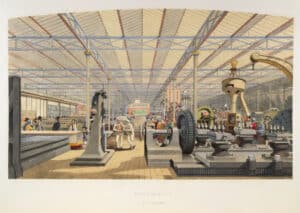
Illustration of machines on display - Some of the notable displays included a printing machine, an envelope machine, a jacquard loom, steel-making displays, agricultural machinery, locomotives, carriages, velocipedes, an early facsimile machine and photographic equipment.
- The public toilets, known as the Retiring Room, designed by George Jennings, caused a stir and were used by more than 800,000 visitors.
- Canada showcased a fire engine with painted panels depicting Canadian scenes, and a trophy of furs.
- India brought an elaborate throne of carved ivory, a coat embroidered with pearls, emeralds and rubies, and an impressive howdah and trappings for a rajah’s elephant.
- France was the largest foreign contributor. It displayed luxurious tapestries, silks, porcelain, enamels and furniture.
- Russia sent vases and urns made of porcelain and malachite twice the height of a man, and furs and sledges and Cossack armour.
The most popular attractions at the Great Exhibition 1851 were:
- The Koh-i-Noor, meaning the ‘Mountain of Light’, the world's largest known diamond in 1851
- A collection of small stuffed animals arranged in whimsical tableaux, contributed by Hermann Ploucquet of Stuttgart
- Hiram Powers’ statue of a Greek Slave in white marble, depicted naked and standing with her wrists in shackles
- Ticket prices to the Great Exhibition varied according to the date of visit.
- When the event ended, it made a substantial profit of £186,000 (equivalent to £15 million in 2017), most of which was used to create the South Kensington museums.
- After the exhibition, Paxton’s clever design enabled the prompt disassembling of the Crystal Palace.
- The building was removed from the Hyde Park site and re-erected at Sydenham Hill. It was put to a variety of uses until it was finally destroyed by fire in 1936.
- World fairs continued to be held in Britain and in different countries in the succeeding years, reaching a golden age in the period between 1880 and the First World War.
Image Sources
- https://www.bl.uk/britishlibrary/~/media/bl/global/dl%20romantics%20and%20victorians/collection-items-manual/great-exhibition-068678.jpg
- https://upload.wikimedia.org/wikipedia/commons/thumb/a/a8/The_Crystal_Palace_in_Hyde_Park_for_Grand_International_Exhibition_of_1851.jpg/1024px-The_Crystal_Palace_in_Hyde_Park_for_Grand_International_Exhibition_of_1851.jpg
- https://www.bl.uk/britishlibrary/~/media/bl/global/dl%20romantics%20and%20victorians/collection-items-manual/great-exhibition-068596.jpg

